The last five verses of Chapter 11 dealt with an outline and brief allusions to the events that will take place during the “third woe” or seventh trumpet―all seven of the seven last plagues. They are called “last” because several preceding post probationary events will take place during the previous six trumpet scenarios. The last part of the sixth trumpet (or “second woe) is depicted in Verses 8-13 of Chapter 11.
It would be completely reasonable to expect Chapter 12 to continue on with things that will take place sometime after the seven last plagues have been poured out; but such is not the case. This chapter begins with a metaphor representing God’s church and then a spectacular outline of the great controversy between Christ and Satan that began during prehistoric times. Nevertheless, we will find several parallels in this chapter to that of Chapter 11, ending with a scenario that has very much to do with some of the end time events that Chapter 11 concluded with.
Let’s begin our study of Chapter 12.
Verse 1: And there appeared a great wonder in heaven; a woman clothed with the sun, and the moon under her feet, and upon her head a crown of twelve stars:
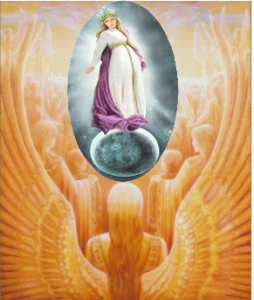 This “wonder,” or “miracle” or “an unusual occurrence” [1] is “a great wonder” from the perspective of the heavenly occupants who are observing what is transpiring on the earth.
This “wonder,” or “miracle” or “an unusual occurrence” [1] is “a great wonder” from the perspective of the heavenly occupants who are observing what is transpiring on the earth.
They witness the terrible struggles the “woman” has to endure. Heaven seems amazed she is able to survive. The secret of her strength is represented by what she is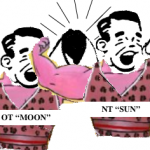 standing on and what she is wearing. The “moon” represents the Old Testament and the “sun” the glories of the New Testament [2] ―the “two witnesses” (Revelation 11:3). Her “crown” or “wreath of victory” [3] decorated with “twelve stars” represents “either the 12 patriarchs, the 12 apostles, or both.” The Commentary adds that “. . . at the same time, the picture of 12 tribes is also carried over into the NT church,” [4] namely the twelve tribes expanded to 144,000 (Revelation 7:4-8).
standing on and what she is wearing. The “moon” represents the Old Testament and the “sun” the glories of the New Testament [2] ―the “two witnesses” (Revelation 11:3). Her “crown” or “wreath of victory” [3] decorated with “twelve stars” represents “either the 12 patriarchs, the 12 apostles, or both.” The Commentary adds that “. . . at the same time, the picture of 12 tribes is also carried over into the NT church,” [4] namely the twelve tribes expanded to 144,000 (Revelation 7:4-8).
The first “woman” we encountered was “that woman Jezebel” (Revelation 2:20). She had passed away centuries ago when Jehu ordered her thrown out the window (2 Kings 9:33). John used her name to represent a church contaminated by the same pagan influence Queen Jezebel espoused so many years before. It is not illogical to assume her influence is pervasive in the “synagogue of Satan” (Revelation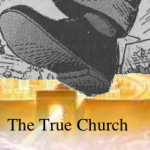 2:9; 3:9).
2:9; 3:9).
The good “woman,” in this case, being crowned with an emblem representing moral conquest (the exact opposite of Jezebel who advocated moral acquiescence), standing on and being clothed with the Old and New Testaments, must represent the church triumphant that goes forth to victory. Therefore, it is not difficult to see this “woman clothed with the sun” as a distinct parallel to the “holy city” (Revelation 11:2) that was “tread under foot.”
Verse 2: And she being with child cried, travailing in birth, and pained to be delivered.
The “child” she bears is Jesus Christ (Verse 5). Therefore, the “woman” not only represents the church triumphant, but also the Christian Church that emerged while Jesus was on earth.
What is represented by her “travail?” It must be something more than Mary’s birth pangs!
Regarding the future of Zion, Isaiah states: “Before she travailed, she brought forth; before her pain came, she was delivered of a man child. Who hath heard such a thing? who hath seen such things? Shall the earth be made to bring forth in one day? or shall a nation be born at once? for as soon as Zion travailed, she brought forth her children” (Isaiah 66:7, 8, underlining supplied).
This amazing prophecy seems to be the focus of this quote: “Converted Jews are to have an important part to act in the great preparations to be made in the future to receive Christ, our Prince. A nation shall be born in a day. How? By men whom God has appointed being converted to the truth. There will be seen ‘first the blade, then the ear, after that the full corn in the ear.’ The predictions of prophecy will be fulfilled.” [5]
What “nation” could this be? It must be the “great multitude, which no man could number, of all nations” who “came out of [the] great tribulation” (Revelation 7:9, 14). That great last day movement will be initiated by the “two witnesses” who receive their “power” from “the two olive trees” empowering the “two candlesticks” (Revelation 11:3, 4) to enlighten the whole world! That sequence of events moves the travail of the woman into time beyond the birth of Christ, to the birth of a future “nation” that will materialize in only “a day!”
Verse 3: And there appeared another wonder in heaven; and behold a great red dragon, having seven heads and ten horns, and seven crowns upon his heads.
This “great red dragon” represents a being formerly named “Lucifer, son of the morning” (Isaiah 14:12) who fell “from heaven.” The same being 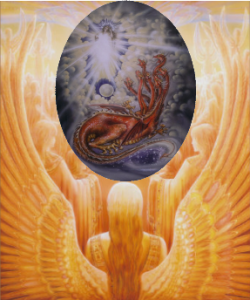 is represented (during the future, post probationary time of the “bottomless pit”) by “a great star [that] fell from heaven” named “Wormwood” (Revelation 8:10, 11), and also the “star [that] fell from heaven” named “Abaddon” or “Apollyon” (Revelation 9:1,11).
is represented (during the future, post probationary time of the “bottomless pit”) by “a great star [that] fell from heaven” named “Wormwood” (Revelation 8:10, 11), and also the “star [that] fell from heaven” named “Abaddon” or “Apollyon” (Revelation 9:1,11).
Keep in mind that this is “another wonder” from the perspective of heaven’s occupants. Evidently, they are aghast at what they behold, even though some 4,000 years had elapsed since this creature had been “cast out” (Verse 9). He must have become likened to a cruel “dragon” in their minds, especially after having witnessed the murder of the child at the hands of Lucifer. To the heavenly onlookers, who once “delighted to execute his commands,” [6] he has now become a “monster” instead of the person they once respected and looked up to.
Notice his “red color” indicative of his “role of persecutor and destroyer. It has been his studied purpose to destroy the children of the Most High.” [7] The same thought pertains to the “horse that was red” (Revelation 6:4) who “went out . . . to take peace from the earth, and that they should kill one another,” and to those who make up the congregation of the “the synagogue of Satan” (Revelation 2:9 and 3:9).
Why “seven heads and ten horns?” The book of Daniel is the only other place in the Bible that depicts “ten horns.” They are seen on the single head of the “fourth beast” (Daniel 7:7, 19), three of which were “plucked up by the roots” when “another little horn” “came up among them” (Daniel 7:8, 24). That left a balance of only eight “horns,” but this “dragon” has a full quota of “ten horns.” Furthermore, they are situated on “seven heads” with “seven crowns [8] upon” them! Therefore, the “seven heads” must represent the “seven kings” that John alludes to later on (Revelation 13:1; 17:9, 10). He has even more to say about the “ten horns” which are also “ten kings” (Revelation 17:12).
Verse 4: And his tail drew the third part of the stars of heaven, and did cast them to the earth: and the dragon stood before the woman which was ready to be delivered, for to devour her child as soon as it was born.
Incredibly, the One who cast the dragon out of heaven, now becomes a helpless human “child,” the potential victim of the dragon! From all appearances, from the perspective of the angels in heaven, the dragon’s success seemed assured. His intent was to frustrate the purpose of heaven and become the undisputed ruler of the world, and eventually of the universe. Everything in his plan depended upon the destruction of the “child’s” mission, either by killing Him prematurely or enticing Him to disobey God’s law.
Although the dragon’s “tail” extends behind its “heads,” its movements are controlled by input from the heads. That thought takes us back into prehistory where no record exists in the annals of human history of how Satan worked to marshal his army of rebellion. It took place in heaven, and must have been ongoing for centuries (or millennia?) even before the world was created.
The “tail” well represents the sly innuendos and intrigues Satan employed to instigate a heavenly civil war. More marvelous yet, he was able to do this even while appearing loyal. He uses the same technique on earth to establish “the synagogue of Satan” whose adherents “say they are Jews, and are not, but do lie” (Revelation 2:9, 3:9). They espouse “a way that seemeth right unto a man, but the end thereof are the ways of death” (Proverbs 16:25).
This is the last time in the book of Revelation, that a “third part” is mentioned. All fourteen references pertain to a fraction of something that Satan, not God, selects for destruction, contamination or degradation. Previously, it was “the third part of trees . . . third part of the sea . . . third part of the creatures . . . in the sea . . . third part of the ships . . . third part of the rivers [and] fountains of waters . . . the third part of the waters . . . third part of the sun . . . third part of the moon . . . third part of the stars . . . third part of . . . the day . . . third part [of] the night . . . the third part of men” (Revelation 8:7, 8, 9, 10, 11, 12; 9:15, and 18). Now, in this verse, it is “the third part of the stars of heaven.”
The meaning of a “star” or “stars,” in the book of Revelation, depends very much on the context. The “seven stars” (Chapters 1-3) represent the human leaders of the seven churches. The “morning star” (Revelation 2:28; 22:16) represents Christ Himself, while the fallen star (Revelation 8:10, 11; 9:1) represents Satan. The “stars” (Revelation 6:13) are actually small meteors that fell from the sky. They seem to be part of another celestial display (Revelation 8:12). The context of the “twelve stars” (Revelation 12:1) suggests them to be representative of God’s human servants. What does the context [9], the dragon selecting heavenly “stars” and throwing them down on the earth, suggest in this verse? It is reasonable to assume these “stars (plural)” are representative of the angelic host who rebelled with the dragon.
Now, we are reminded of his rebellion in heaven. The dragon is seen standing before the pregnant “woman” prepared “to devour her child as soon as it  was born.” This suggests Satan had accurate foreknowledge, enabling him to anticipate the birth of the Messiah. His first clue was given in the garden of Eden when Jesus told the serpent “I will put enmity between thee and the woman, and between thy seed and her seed; it shall bruise thy head, and thou shalt bruise his heel (Genesis 3:15).” Since that time the serpent has been very protective of his “head.” Perhaps that is why he developed “seven” of them, thinking the loss of one would be relatively harmless.
was born.” This suggests Satan had accurate foreknowledge, enabling him to anticipate the birth of the Messiah. His first clue was given in the garden of Eden when Jesus told the serpent “I will put enmity between thee and the woman, and between thy seed and her seed; it shall bruise thy head, and thou shalt bruise his heel (Genesis 3:15).” Since that time the serpent has been very protective of his “head.” Perhaps that is why he developed “seven” of them, thinking the loss of one would be relatively harmless.
During the succeeding 4,000 years, the dragon carefully analyzed every forthcoming prophecy [10] from God’s servants the prophets in order to gain a more precise understanding of Jesus’ first coming. He knew that his “head” would surely be “bruised.” Since there are several meanings of the word “bruise” including “crush, gape upon, desire, strike out, to gape, snap at, to overwhelm, cover” or “fall upon,” [11] he probably hoped it would not be fatal, and, if he were clever enough, be able to survive forever.
From his study of Daniel, particularly Chapter 9, he became very familiar with the time prophecies and specifically set about to disrupt God’s chosen nation of Israel. He successfully eliminated ten of its twelve tribes before Messiah was born. But two of them, even after being subjected to Babylonian captivity for seventy years, slipped through his fingers to fulfill God’s purpose. But the dragon did not relax. He intensified his efforts to distort the thinking of the leaders of the Jewish nation so that they would not be ready to receive the “child as soon as it was born.” He also employed the pagan Roman king, Herod by name, to “seek the young child to destroy him” (Matthew 2:13) ―pagan Rome identified as the fourth beast (Daniel 7:7).
Let’s pause for a moment and reflect on the character and behavior of the people who played important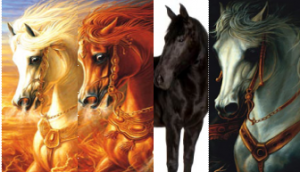 parts in the crucial scenario of the birth of Christ. They can all be categorized under one or the other of the four horses of the Apocalypse (Revelation 6:2-8). Quite likely, Joseph and Mary, including the “wise men from the east” (Matthew 2:1) could be symbolized by the “white horse.” The “chief priests and scribes of the people” (Matthew 2:4) are likely represented by the “horse that was red.” Perhaps the simple “shepherds abiding in the field, keeping watch over their flock by night” (Luke 2:8) could come under the motionless “black horse,” while Herod’s treacherous behavior is likely typified by the “pale horse” whose rider is named “Death.”
parts in the crucial scenario of the birth of Christ. They can all be categorized under one or the other of the four horses of the Apocalypse (Revelation 6:2-8). Quite likely, Joseph and Mary, including the “wise men from the east” (Matthew 2:1) could be symbolized by the “white horse.” The “chief priests and scribes of the people” (Matthew 2:4) are likely represented by the “horse that was red.” Perhaps the simple “shepherds abiding in the field, keeping watch over their flock by night” (Luke 2:8) could come under the motionless “black horse,” while Herod’s treacherous behavior is likely typified by the “pale horse” whose rider is named “Death.”
And so, in spite of the dragon’s acute awareness of the child’s coming, Satan was able to engineer a pervasive indifference toward that event―even amongst God’s chosen people. Not so with the loyal angels: “With amazement the heavenly messengers beheld the indifference of that people whom God had called to communicate to the world the light of sacred truth. The Jewish  nation had been preserved as a witness that Christ was to be born of the seed of Abraham and of David’s line; yet they knew not that His coming was now at hand. In the temple the morning and the evening sacrifice daily pointed to the Lamb of God; yet even here was no preparation to receive Him. The priests and teachers of the nation knew not that the greatest event of the ages was about to take place. They rehearsed their meaningless prayers, and performed the rites of worship to be seen by men, but in their strife for riches and worldly honor they were not prepared for the revelation of the Messiah. The same indifference pervaded the land of Israel. Hearts selfish and world-engrossed were untouched by the joy that thrilled all heaven. Only a few were longing to behold the Unseen. To these heaven’s embassy was sent.” [12]
nation had been preserved as a witness that Christ was to be born of the seed of Abraham and of David’s line; yet they knew not that His coming was now at hand. In the temple the morning and the evening sacrifice daily pointed to the Lamb of God; yet even here was no preparation to receive Him. The priests and teachers of the nation knew not that the greatest event of the ages was about to take place. They rehearsed their meaningless prayers, and performed the rites of worship to be seen by men, but in their strife for riches and worldly honor they were not prepared for the revelation of the Messiah. The same indifference pervaded the land of Israel. Hearts selfish and world-engrossed were untouched by the joy that thrilled all heaven. Only a few were longing to behold the Unseen. To these heaven’s embassy was sent.” [12]
The same sentiment applies to our world today. Even our church, depicted as “the church of the Laodiceans,” is smugly complacent thinking ourselves “rich, and increased with [spiritual as well as material] goods, and have need of nothing” (Revelation 3:17).
Verse 5: And she brought forth a man child, who was to rule all nations with a rod of iron: and her child was caught up unto God, and to his throne.
This verse spans the entire earthly life of Christ, from the time He was “brought forth” in 4 B.C., to the time He was “caught up unto God, and to his throne” in 31 A.D. His destiny was “to rule all nations with a rod of iron,” [13] which begins when the seventh angel sounds and the “kingdoms of this world are become the kingdoms of our Lord, and of his Christ; and he shall reign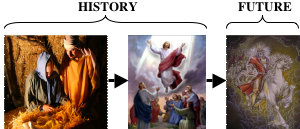 for ever and ever” (Revelation 11:15). Therefore, the manifestation of His “iron” rule will be marked by the “seven last plagues,” delineated as the “seventh angel and the “third woe” (Revelation 11:14, 15).
for ever and ever” (Revelation 11:15). Therefore, the manifestation of His “iron” rule will be marked by the “seven last plagues,” delineated as the “seventh angel and the “third woe” (Revelation 11:14, 15).
Interestingly, this is the same “rod of iron” promised to him “that overcometh, and keepeth my works unto the end” (Revelation 2:26, 27), not in this life, but in the life to come when John “saw thrones, and they sat upon them, and judgment was given unto them . . . and they lived and reigned with Christ a thousand years (Revelation 20:4)” during the millennial judgment, making the overcomers co-rulers with Christ the Messiah in heaven. Finally, Christ alone will again “smite the nations: and he shall rule them with a rod of iron” during the last part of the premillennial judgment (Revelation 19:15).
In the meantime, during His priestly ministry in the heavenly sanctuary, since He was “caught up unto God, and to his throne,” He promises “To him that overcometh will I grant to sit with me in my throne, even as I also overcame, and am set down with my Father in his throne” (Revelation 3:21).
Verse 6: And the woman fled into the wilderness, where she hath a place prepared of God, that they should feed her there a thousand two hundred and threescore days.
Note the parallel of the “thousand two hundred and threescore days” to where the “two witnesses” prophesied “a thousand two hundred and threescore days, clothed in sackcloth” (Revelation 11:3). The word “days” in both verses is from the same Greek word “hemera” indicating a time of trouble when the church militant was converted into the church triumphant called “the holy city” (Revelation 11:2). But, in this case, it must be the historic Dark Age that is being referred to because it follows closely with Jesus’ ascension into heaven (Verse 5).
In spite of the many references to the future paradigm in Verse 5, this verse, retrospectively, takes us back in time when “the woman,” also represented as “the holy city” (Revelation 11:2), who was “tread under foot forty and two months” is likewise seen to flee “into the wilderness . . . a place [that was] prepared of God” to be a refuge for the true church during the Dark Age of history from 538 to 1798 A.D. That scenario began five hundred and seven years [14] after the “man child . . . was caught up unto God, and to his throne.”
 During the intervening period between 31 A.D. and 538 A.D., it was anything but easy for the true church because it also suffered severely under “the feet” of the “fourth beast,” representing pagan Rome (Daniel 7:7) that the “great red dragon” employed to persecute God’s people. [15]
During the intervening period between 31 A.D. and 538 A.D., it was anything but easy for the true church because it also suffered severely under “the feet” of the “fourth beast,” representing pagan Rome (Daniel 7:7) that the “great red dragon” employed to persecute God’s people. [15]
Nevertheless, difficulties for God’s church became even greater after the fall of Rome. It was the “little horn” power that wore “out the saints of the most High” (Daniel 7:25) instead of the “fourth beast.” The parallel to the “little horn” is depicted in Revelation 13. In that scenario, we see the pale horse (Revelation 6:8), representing pagan Rome [16], giving place to the red horse (Revelation 6:4), typifying the character and behavior of papal Rome, which was far more effective in doing battle with Christianity (represented by the white horse of Revelation 6:2 that “went forth conquering and to conquer”) than Satan could ever hope to accomplish with pagan Rome [17]. Consequently, the dragon’s failure to destroy the church must be the reason God omits any symbolism relating to pagan Rome and skips ahead to the depredations of papal Rome during the 1260 years of the historic Dark Age.
This time period, of “a thousand two hundred and threescore days,” is identical to the “forty and two months” and “a thousand two hundred and threescore days” (Revelation 11:2, 3), “a time and times and the dividing of time” (Daniel 7:25), and “a time, times, and an half” (Daniel 12:7).
As we learned in our study of the book of Daniel, the “time and times and the dividing of time” (Daniel 7:25) relates to the 1260 years of the historic Dark Age because of its contextual relationship to “the judgment” depicted in Verse 26 after the horn power wore out “the saints of the most High” for “a time and times and the dividing of time.” It is calculated in prophetic time as 1260 literal years. In other words, the “time and times and the dividing of time” took place prior to 1844 when “the judgment [was] set.
The context is different in Daniel 12:7. It is associated with the time when “Michael [will] stand up” (Verse 1) at the end of the same judgment that began in Daniel 7:26 (or, for that matter in Daniel 7:9, 10, 13). Note also that the “little horn” power (represented by the “vile person” -Daniel 11:21-45) will have “accomplished to scatter the power of the holy people” when “all [the] things” Gabriel spoke of in Daniel 11:30-45 “shall be finished.”
The same double application of the 1260 is seen in Revelation 11:2, 3. The 1260 will be seen again in Verse 14 of this chapter. and yet again in Chapter 13, which brings the total number of times it is depicted to nine, if we include the two brought to view by cutting the final “week” of Daniel 9:27 in half. [18] Consequently we should feel compelled to ask what the great consequence of this frequently mentioned time period signifies. [19] By now, it should be readily apparent. It has consequence to the past Dark Age in prophetic time and to the future Dark Age, but in indefinite, literal time.
Verse 7: And there was war in heaven: Michael and his angels fought against the dragon; and the dragon fought and his angels,
The date for this event is unknown, but it took place long before the woman fled into the wilderness” in the sixth century A.D. or even when the “man child” was “brought forth” at the beginning of the Christian era! In fact, it occurred sometime before Eve found herself standing before the “tree of knowledge of good and evil” listening to the sly insinuations of the serpent (Genesis 3:1-7). This verse takes us backwards in time from the Dark Age of history (Verse 6) into prehistoric time! This “war,” that culminated in heaven with the casting out of Satan, has continued on earth for more than 6,000 years. But its end is brought to view by the coming “rule” of the “man child” (Verse 5) and the “third woe” (Revelation 11:14-19).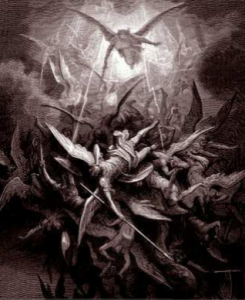
Just how long this “war in heaven” lasted we have no way of knowing, but it could have begun thousands, even millions of years ago. The dragon began his recruiting program long before actual “war” broke out, because God, “In great mercy, according to His divine character . . . bore long with Lucifer” now called “the dragon.”
Originally, such a “spirit of discontent and disaffection had never before been known in heaven. It was a new element, strange, mysterious, unaccountable . . . for a time he had feared to express the workings and imaginings of his mind; yet he did not dismiss them. He did not see whither he was drifting. But such efforts as infinite love and wisdom only could devise, were made to convince him of his error . . . Lucifer was convinced that he was in the wrong . . . He had not at that time fully cast off his allegiance to God. Though he had left his position as covering cherub, yet if he had been willing to return to God . . . he would have been reinstated in his office. The time had come for a final decision; he must fully yield to the divine sovereignty or place himself in open rebellion. He nearly reached the decision to return, but pride forbade him . . . Great numbers of the angels signified their purpose to accept him as their leader. Flattered by the favor with which his advances were received, he hoped to win all the angels to his side, to become equal with God Himself, and to be obeyed by the entire host of heaven . . . God permitted Satan to carry forward his work until the spirit of disaffection ripened into active revolt. It was necessary for his plans to be fully developed, that their true nature and tendency might be seen by all.” [20] That is the reason God actually allowed “war in heaven.”
In that “war,” there was no neutral ground. All the angels had to take sides either for or against “the dragon” leaving no question in their minds as to who had taken sides with whom. While the “dragon” “denounced the “loyal angels . . . as deluded slaves,” [21] hoping to humiliate and intimidate them, in contrast, God allowed them complete freedom to make up their own minds.
Verse 8: And prevailed not; neither was their place found any more in heaven.
God had to restrain Himself, else the “dragon” and his “angels” would have been completely annihilated in a moment. Even though the loyal angels were greatly in the majority, God could easily have won the victory by Himself. Nevertheless “Michael” allowed “his angels” to fight along with Him “against the dragon” in order to demonstrate their loyalty. As expected, the “dragon . . . and his angels . . . prevailed not” and no “place” was “found” anywhere else “in heaven,” suggesting they had scoured the universe for another “place in heaven.”
What is heaven? In this case, it is anywhere not on earth. Prior to the fall, “earth” would have been part of “heaven” because its inhabitants enjoyed unbroken communion with God and the angels. After the fall, the earth became a planet separated from heaven both physically and spiritually. Apparently, all the inhabitants of the other planets rejected Satan’s temptations, and only by causing Adam and Eve to fall did he finally find a “place” to dwell―other than possibly Venus or Mars where nobody exists!
According to Verse 4 “the third part of the [angels] of heaven” were “cast . . . to the earth” leaving a “third” of the angelic places vacant. An Old Testament prophecy predicts “it shall come to pass, that in all the land, saith the LORD, two parts therein shall be cut off and die; but the third shall be left therein. And I will bring the third part through the fire, and will refine them as silver is refined, and will try them as gold is tried: they shall call on my name, and I will hear them: I will say, It is my people: and they shall say, The LORD is my God” (Zechariah 13:8, 9). Perhaps they will be the people who will replace the positions left vacant by Satan’s angels.
Verse 9: And the great dragon was cast out, that old serpent, called the Devil, and Satan, which deceiveth the whole world: he was cast out into the earth, and his angels were cast out with him.
Note the word “old,” the same word used in Revelation 20:2 to describe the age of the “serpent.” Possibly, he was the first angel God created and could be millions, if not billions, of years old. Whatever the case, he is certainly old enough to know better!
At first glance, one could get the impression, from this verse, that God deliberately selected the “earth” to be His cosmic penal colony. Nothing could be further from the truth. Note the phrase “cast out” is used three times in this verse―twice for the Devil, and once for his angels―implying that the process of excluding him from heaven was incremental. This verse suggests “he was cast out into the earth” because he deceived the “world” into accepting him, while all the other worlds had rejected him.
In vision White saw some “other worlds” and viewed “a place that was bright and glorious . . . The inhabitants of the place . . . bore the express image of Jesus, and their countenances beamed with holy joy, expressive of the freedom and happiness of the place. I asked one of them why they were so much more lovely than those on the earth. The reply was, ‘We have lived in strict obedience to the commandments of God, and have not fallen by disobedience, like those on the earth.’ Then I saw two trees, one looked much like the tree of life . . . but of one they could not eat. They had power to eat of both, but were forbidden to eat of one. Then my attending angel said to me, ‘None in this place have tasted of the forbidden tree; but if they should eat, they would fall.’” [22]
Doubtless, the dragon tried the same trick on other planets that he used on planet “earth” ―multiplied billions of times, perhaps. We were the only ones who chose his leadership and gave him permission to set up camp.
While this verse says he was “cast out,” the next verse says he was “cast down,” suggesting there was more to his exclusion from heaven then being merely physically ostracized.
Verse 10: And I heard a loud voice saying in heaven, Now is come salvation, and strength, and the kingdom of our God, and the power of his Christ: for the accuser of our brethren is cast down, which accused them before our God day and night.
This verse sounds very much like that of the “third woe” scenario when “there were great voices in heaven, saying, The kingdoms of this world are become the kingdoms of our Lord, and of his Christ; and he shall reign for ever and ever . . . because thou hast taken to thee thy great power, and hast reigned” (Revelation 11:15, 17). That “third woe” scene portrays the heavenly inhabitants rejoicing over the fact that Jesus finally steps in to demonstrate his own power and bring Satan’s reign to an end.
But this scene depicts “great rejoicing in the courts of heaven over the casting down of Satan and his host” just after the “man child was caught up to God, and to his throne” (see Verse 5), back in 31 A.D. This must have been the time “When Christ passed within the heavenly gates” after His ascension. There, “He was enthroned amidst the adoration of the angels. As soon as this ceremony was completed . . . the Redeemer’s inauguration was accomplished.” [23]
The “accuser of our brethren” represents a celestial prosecutor in conflict with our “advocate with the Father, Jesus Christ the righteous” (1 John 2:1). He can be none other than “that old serpent, called the Devil, and Satan” (Verse 9). There, back in prehistoric time, he was physically “cast out” of heaven. Here, after revealing himself to the angelic hosts (31 A.D.) as a murderer, or the “dragon” (Verse 3), he “is cast down.” Whereas, the loyal angels, previous to Christ’s crucifixion, had some questions lingering in their minds about Satan’s character, now all doubt is removed. From this point onward, he lost all sympathy in heaven. His accusations against “our brethren” now ring offensively in the ears of heaven’s loyal inhabitants.
As the Commentary observes: “The focus of time is the cross. Well might the inhabitants of heaven rejoice, for Satan’s destruction was now assured. It was certain in the plan of God before, but now heavenly intelligences joined in the song, for they had seen Satan’s malignity against Christ revealed at Calvary.” [24] “The last link of sympathy between Satan and the heavenly world was broken.” [25]
Verse 11: And they overcame him by the blood of the Lamb, and by the word of their testimony; and they loved not their lives unto the death.
The pronoun “they” refers to the “brethren” (Verse 10) as well as the “woman” who “fled into the wilderness” (Verse 6).
The  accuser “has an accurate knowledge of the sins which he has tempted them to commit, and he presents these before God in the most exaggerated light . . . ‘Are these,’ he says, ‘the people who are to take my place in heaven, and the place of the angels who united with me? . . . Will God banish me and my angels from his presence, and yet reward those who have been guilty of the same sins? Thou canst not do this, O Lord, in justice. Justice demands that sentence be pronounced against them.'” [26]
accuser “has an accurate knowledge of the sins which he has tempted them to commit, and he presents these before God in the most exaggerated light . . . ‘Are these,’ he says, ‘the people who are to take my place in heaven, and the place of the angels who united with me? . . . Will God banish me and my angels from his presence, and yet reward those who have been guilty of the same sins? Thou canst not do this, O Lord, in justice. Justice demands that sentence be pronounced against them.'” [26]
But “they overcame” his accusations by relying completely on “the blood of the Lamb” who took away the “sting of death” (1 Corinthians 15:56), which is the “second death” (Revelation 2:11; 20:6, 14, 18). With such assurance, men would die rather than disobey God, because they have nothing to lose and everything to gain.
All through history, from the time Abel was killed by his brother to the very last moment of probationary time, God has never forgotten “the souls of them that were slain for the word of God, and for the testimony which they held.” Their blood seems to Him to be saying “How long, O Lord . . . dost thou not judge and avenge our blood on them” (Revelation 6:9-10) that yield to the demonic rider of the “red” and “pale” horses,” representing Satan who controls those who “received not the love of the truth” of Christ’s atoning blood “that they might be saved”? Consequently, “for this cause God shall send them strong delusion, that they should believe a lie: that they all might be damned who believed not the truth, but had pleasure in unrighteousness.” (See 2 Thessalonians 2:9-12)
Verse 12: Therefore rejoice, ye heavens, and ye that dwell in them. Woe to the inhabiters of the earth and of the sea! for the devil is come down unto you, having great wrath, because he knoweth that he hath but a short time.
Much of this verse is included in the following: “The more we learn in reference to the early days of the Christian church, and see with what subtlety Satan worked to weaken and destroy, the better we shall be prepared to resist his devices and meet coming perils. We are in the time when tribulations such as the world has never yet seen will prevail. ‘Woe to the inhabiters of the earth and of the sea! for the devil is come down unto you, having great wrath, because he knoweth that he hath but a short time.’ But God has set bounds that Satan cannot pass. Our most holy faith is this barrier; and if we build ourselves up in the faith, we shall be safe in the keeping of the Mighty One. ‘Because thou hast kept the word of My patience, I also will keep thee from the hour of temptation, which shall come upon all the world, to try them that dwell upon the earth.'” [26a] Note that it is quoted in context with “coming perils” and a paraphrased reference to Daniel 12:1 ending with “the hour of temptation” (Revelation 3:10), all of which refer to the future time of trouble.
The last sentence of this verse is also included in this statement: “Fearful are the scenes which call forth this exclamation from the heavenly voice. The wrath of Satan increases as his time grows short, and his work of deceit and destruction will reach its culmination in the time of trouble . . . The spirits of devils will go forth to the kings of the earth and to the whole world, to fasten them in deception, and urge them on to unite with Satan in his last struggle against the government of heaven.” [26b]
On the other hand, the Commentary seems to confine this scene to the time “the angels and the inhabitants of other worlds knew Satan was doomed by Christ’s victory at Calvary.” [27] White suggests this verse bears future significance in that it is associated with Satan’s very “last struggle” during “the time of trouble.”
The word “short” is from the Greek word “oligos” meaning “little, small, few” as compared to the long period of time expressed in Verse 6 as “a thousand two hundred and threescore days (“hemera”). Therefore, it appears that the “time, and times and half a time” refers to a literal three and a half years in the future, the same “time, times, and an half” referred to in Daniel 12:7.
Note that the “heavens” are exhorted to “rejoice” AND also “ye that dwell in them,” suggesting two heavenly parties are being addressed. The “heavens” is apparently reference to those who dwell there literally, and “ye that dwell in them,” those who dwell there spiritually,” such as noted in Revelation 11:1 where those who “worship” in “the temple of God, and the altar,” which are heavenly, must be worshipping there in the spiritual, rather than the literal, sense. In contrast, “the inhabiters of the earth” are doomed, as the “woe” pronounced against them suggests. They are those that “dwell on the earth” both spiritually and physically (Revelation 3:10; 6:10 and 11:10).
Now compare John’s statement: “I heard a loud voice saying . . .Woe to the inhabiters of the earth . . .” (Verses 10 & 12) with his previous statement where he “heard an angel . . . saying with a loud voice, Woe, woe, woe, to the inhabiters of the earth . . .” (Revelation 8:13). Could the “woe” of this verse be a reference to the last three “woes” of Revelation 8:13? Quite possibly, especially in light of the comment quoted above in Great Controversy. It appears, therefore, that this “Woe” reflects back to the three post probationary “woes” of the fifth, sixth and seventh trumpet scenarios (Revelation 9; 11:7-13 as well as Chapters 15 & 16).
Many assert that Satan, after the close of probation, has nothing to gain by attempting to overcome the saints, because if this “short time” were post probationary, the exercise of his “great wrath” against them would be futile. However, such an assertion is without foundation. Consider the fact that if just one of the sealed saints were overcome by Satan’s onslaught, after the close of probation, Satan would be the winner in the Great Controversy, for no sin could be forgiven after Christ has “cast” the “censer . . . into the earth” (Revelation 8:5), signifying the close of probation. What a terrible thought to consider! Therefore, from Satan’s perspective, he would have far more to gain from his efforts than he would during probationary time when sinners have the option of having their sins forgiven.
Also, consider the fact that even after having a “thousand years” to think over the corrupt course of his life, Satan still goes “out to deceive the nations” (see Revelation 20:8)! What makes us think he will relax his efforts during the post probationary, premillennial time of the trumpets?!
Therefore, Satan, recognizing “that he hath but a short time” [28] at this point, makes good sense. Since he is a diligent student of prophecy and understands that the time between the close of probation and the second coming must be very “short,” he intensifies his efforts to destroy (both physically and spiritually) the saints, which would assure his victory. He, having “an accurate knowledge of the sins which he has tempted them to commit” knows “If he could blot them from the earth, his triumph would be complete.” Concurrently, “If the righteous were now left to fall a prey to their enemies, it would be a triumph for the prince of darkness.” But, “Glorious will be the deliverance of those who have patiently waited for His coming, and whose names are written in the book of life.” [29]
Consequently, Satan is looking forward to this last, desperate struggle to defeat the great plan of Salvation. From his perspective he has every reason to believe he will be successful. Very few, if any, of the accused “brethren” (see Verse 10) have been even close to being as resilient to his attacks as was the Lamb. He sneers at the possibility that the 144,000, let alone the “great multitude” who will receive the seal of the living God, could possibly vindicate God’s character after the close of probation. As it is, it’s God’s word against Satan’s. And God, in the end, always wins!
Verse 13: And when the dragon saw that he was cast unto the earth, he persecuted the woman which brought forth the man child.
Although “child” in this verse is italicized, there is little reason to believe the “man” is not the “child” of Verse 5 which is Christ. Although it seems that the persecution being referred to is that of the “thousand two hundred and threescore days” of Verse 6, we are still forced to consider the relationship of this verse to the very “short time” of Verse 12.
This verse seems to imply that Satan, for some time, must have been unwilling to recognize he had been ostracized from heaven, even though, according to Verse 9, he had already been “cast out” by the time he deceived Adam and Eve in the garden of Eden. However, according to the book of Job, it is sometime later that he is seen among “the sons of God” when they “came to present themselves before the LORD” (Job 1:6). That obviously took place in heaven and God had some questions for him. Therefore, it seems God must have allowed Satan limited access into heaven to avoid giving the impression to the loyal angels that He was fearful of Satan’s influence. That situation continued, it seems, until Christ was crucified on the cross, proving to the universe that Satan was a murderer, which severed the “last link of sympathy” [30] for Satan’s cause that had, up to that point, been entertained by the loyal angels.
We don’t know just how long it took Satan to recognize he was now totally ostracized from heaven and that he could no longer carry his case into the heavenly precincts, but it could not have been very long, considering the intensity of persecution suffered by the church at the hands of pagan Rome, which began almost immediately after the crucifixion. Therefore, his persecution of “the woman” must also be inclusive of the “thousand two hundred and threescore days” of Verse 6, when Satan took out his frustration on the church during the Dark Ages of history. Nevertheless, his ire has not cooled by any means. Knowing that he has only a much shorter “time” than that of Verse 6, he has learned much and has no intention of being defeated in the next great coming climax of history, when Jesus will take “the censer,” fill “it with fire of the altar, and cast it into the earth” (Revelation 8:5).
Then, the “four winds” (Revelation 7:1), representing his destructive power, will sweep unopposed throughout the earth, bringing “a time of trouble, such as never was since there was a nation even to that same time” (Daniel 12:1). If only one member of those who have been “sealed in their foreheads” (Revelation 7:4-9) should fall during Satan’s subsequent onslaught, the whole plan of salvation would be defeated!
Verse 14: And to the woman were given two wings of a great eagle, that she might fly into the wilderness, into her place, where she is nourished for a time, and times, and half a time, from the face of the serpent.
This verse is very nearly a repeat of Verse 6, where the “woman fled” [31] into the wilderness.” [32] But here she was given “wings” enabling here to “fly” [33] into the wilderness,” suggesting far greater haste is necessary to meet the dragon’s “great wrath that he exercises because he has only a “short time” (Verse 12). This calls to mind that “Great changes are soon to take place in our world, and the final movements will be rapid ones.” [34]
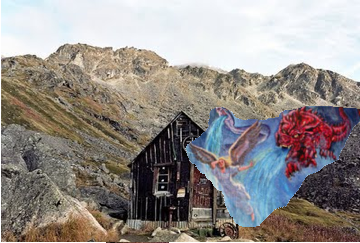 In the “wilderness . . . she is nourished,” suggesting famine conditions could be plaguing the world at that time. But “God who cared for Elijah in the time of famine, will not pass by one of his self-sacrificing children. He that has numbered the hairs of their head, will care for them, and in days of famine they will be satisfied. While the wicked are perishing all around them for want of bread, their bread and water will be sure. Those who will still cling to their earthly treasure, and will not make a right disposition of that which is lent them of God, will lose their treasure in heaven, lose everlasting life.” [35]
In the “wilderness . . . she is nourished,” suggesting famine conditions could be plaguing the world at that time. But “God who cared for Elijah in the time of famine, will not pass by one of his self-sacrificing children. He that has numbered the hairs of their head, will care for them, and in days of famine they will be satisfied. While the wicked are perishing all around them for want of bread, their bread and water will be sure. Those who will still cling to their earthly treasure, and will not make a right disposition of that which is lent them of God, will lose their treasure in heaven, lose everlasting life.” [35]
Now we encounter another time prophecy that repeats the frequently mentioned “1260.” It is couched in language very much like the “times, times, and an half” (Daniel 12:7) and the “times and times and the dividing of time” (Daniel 7:25). It is also the same period as “forty and two months” and “a thousand two hundred and threescore days” (Revelation 11:2, 3), as well as the “thousand two hundred and threescore days (Verse 6).
While the word “time” (Daniel 7:25) is from the Aramaic “‘iddan,” [36] and “time” (Daniel 12:7) is from the Hebrew “mow’ed,” [37] the last two words for “time” in this verse are from “kairos,” [38] the same word translated “time” (Verse 12) that is specified to be very “short.” Interestingly, the first word for “time,” in this verse, is translated from two words: “ekei” [39] and “kairos,” with “ekei” meaning: “there, in, or to that place.” (Interestingly, the word “time” is translated seven times from “kairos” in the book of Revelation. Check it out: 1:3; 11:18; 12:12; two times in 12:14 and once more in 22:10, all of which refer to the future.)
Note in Verse 6 that the “woman fled into the wilderness,” without specifying exactly why she felt compelled to seek refuge there, although we can logically assume it was to escape the ire of the dragon. In contrast, this verse specifies precisely the reason for her escape. She has to “fly . . . from the face” [40], or the literal presence “of the serpent.” Since, according to Verse 12, where the earthly inhabitants are being subjected to the post probationary “woes,” it seems likely that the “woman” will be compelled to escape from either “Wormwood,” the false Christ, “Abaddon/Apollyon,” the Destroyer, or both.
Verse 15: And the serpent cast out of his mouth water as a flood after the woman, that he might cause her to be carried away of the flood.
The “serpent” used his “tail” (Verse 4) to “cast” the “stars . . . to the earth.” Here he vomits out a “flood” of “water” “out of his mouth” intending to drown the “woman.” This “flood” of “water” is the same figure of speech used in Daniel 9:26 and 11:21, 22 where “the end . . . shall be with a flood, and unto the end of the war desolations are determined . . . And with the arms of a flood shall they be overflown from before him [the vile person].” While Verse 4 pictures the “dragon” or “serpent” employing cunning and subterfuge, here he appears confrontational with the watery “flood” being symbolic of an overwhelming mass of confusing doctrinal error that stymies thought and chokes out truth and righteousness.
While the “dragon” (Verse 4) attempted to use King Herod (Matthew 2:16) to “devour the child as soon as it was born,” here, and in Verse 6, he employs the “little horn” (Daniel 7:8; 8:9) or the “vile person” (Daniel 11:21) to drown opposition with the things coming out of its “mouth.”
Verse 16: And the earth helped the woman, and the earth opened her mouth, and swallowed up the flood which the dragon cast out of his mouth.
From the historic perspective, the Commentary represents “the earth” as “the North American continent” at “the time of the Reformation” that brought “relief to the persecuted church of the Old World” or as a figure representing “the Protestant Reformation itself as the major factor in breaking the spell of the apostate church” near the end of the historic 1260 years (that is A.D. 538-1798). [41] However, the reassuring message of this verse finds its parallel with reference to the post probationary seven last plagues (Revelation 16:12): “the sixth (plague bearing) angel poured out his vial upon the great river (or ‘flood’) Euphrates; and the water thereof was dried up . . .” While the historic 1260 days represented 1260 years, this short (Verse 12) time period of 1260 days that the woman was in the wilderness (Verse 14) would be a literal 3 ½ years.
Although the Greek words for “dried up” [42] and “swallowed up” [43] are different, the effect on the “river,” or “flood” is the same. Even though Satan intended to exterminate the “woman” in the same way the “third part of men” were “killed” (Revelation 9:15, 18), God will spare the “woman,” represented as “the kings of the east” (Revelation 16:12), who previously announced the “tidings out of the east” that troubled the “vile person” (Daniel 11:21, 44). She is also represented as the “two witnesses” (Revelation 11:3-6) who had “power to shut heaven, that it rain not in the days of their prophecy.” Their message “tormented them that dwelt on the earth (Revelation 11:10)” just as it troubled the “vile person” (Daniel 11:44).
Verse 17: And the dragon was wroth with the woman, and went to make war with the remnant of her seed, which keep the commandments of God, and have the testimony of Jesus Christ.
The Commentary acknowledges that this “war” which represents Satan’s “supreme effort in this direction is still in the future.” [44] The only retrospective feature to history in Verses 12 to 17 is found in Verse 13 where John briefly glances back to “the woman [when she] brought forth the man child.” Then, in Verse 14, he pictures the “woman” being given “wings” allowing her to escape from the very presence (or “face”) of the “serpent” who attempts to overwhelm her (Verses 15, 16) in the same future scenario depicted in this verse.
Therefore, when “the dragon” realizes he has “but a short time,” he persecutes the “woman” forcing her to “fly into the wilderness . . . from the face (or actual presence) of the dragon” (Verses 12 to 14). There she will find refuge for “a time, and times, and half a time,” or three and a half literal years [45], after which “the great river Euphrates” or “flood” of Satan’s armies will be completely frustrated in their attempt to carry out the universal death decree. [46]
Note that the dragon’s wrath is exercised, not only against them which keep the commandments of God, namely the ten precepts of the moral law (Exodus 20), but also against those who “have the testimony of Jesus Christ” which is “The Revelation of Jesus Christ, which God gave unto him, to shew unto his servants things which must shortly come to pass; and he sent and signified it by his angel unto his servant John: who bare record of the word of God, and of the testimony of Jesus Christ, and of all things that he saw.” God’s “servants,” who will have read, heard and kept “those things which are written therein” will receive the blessing promised and be fully aware of their meaning and importance. They will know without question, throughout the entire end-stage time of trouble, that “the time” for Christ’s coming “is at hand” (Revelation 1:1-3).
Summary of Chapter 12: This chapter is wide ranging in scope from the Christian era, represented by the pregnant “woman” whose “man child” was threatened by the “great red dragon and then “was caught up unto God,” then forward into the Dark Age of history when the “woman fled into the wilderness, then back into prehistory where there was “war in heaven, and forward again to the Dark Age of the future when the “woman” escapes from the serpent’s “face.” Most fail to recognize the many parallels that exist between this chapter and Chapter 11. Two of them are the clothing and foundation of the “woman,” namely the “sun” and “moon” representing the Old and New Testaments, paralleling the “two witnesses” of Chapter 11 which also represent both the Old and the New Testaments. Then we find the same two 1260 time periods of Verses 6 and 14 being parallel to the same periods depicted in Chapter 11:2, 3, with both representing the historic and the future Dark Ages. Another surprise is the parallel of Verses 12-17 which end with symbols that parallel the final events of the seven last plagues when the “earth . . . swallowed up the flood” that the “serpent” vomits “out of his mouth.” That happens when the sixth plague bearing angel pours out his vial drying up “the great river Euphrates,” part of the same plague scenario depicted at the end of Chapter 11.
[1] “wonder” translated from “semeion” (Strong’s #4592) “a sign, miracle, wonder, token.” Another nuance of meaning: “an unusual occurrence, transcending the common course of nature.
[2] Seventh-day Adventist Bible Commentary, Vol. 7, page 807 (right column)
[3] “crown” from “stephanos” (Strong’s #4735) “a mark of royal or exalted rank; the wrath or garland which was given as a prize to victors in public games” which seems to be the application here. Note: it is the same “crown” worn by the rider of the “white horse” (Revelation 6:2).
[4] Seventh-day Adventist Bible Commentary, Vol. 7, page 807 (right column under “Twelves stars.”)
[5] Evangelism by E.G. White, page 579 (italics supplied). The word “day” in Isaiah’s prophecy is from yom “as defined by evening and morning in Genesis 1”
[6] Patriarchs and Prophets by E.G. White, page 37
[7] Seventh-day Adventist Bible Commentary, Vol. 7, page 807 (right column under “Red dragon.)
[8] The word “crowns” here is from “diadema” (Strong’s #1238) which is “a blue band marked with white which Persian kings used to bind on the turban or tiara” or “the kingly ornament for the head.” This is in contrast to the “crown” of verse 1 which is a “stephanos” or wreath of victory.
[9] Note in Seventh-day Adventist Bible Commentary, Vol. 7, page 808 presents two views of “The third part.”
[10] “Satan is a diligent Bible student. He knows that his time is short, and he seeks at every point to counterwork the work of the Lord upon this earth.” (Testimonies for the Church by E.G. White, Vol. 9, page 16)
[11] “bruise” from “shuwph” (Strong’s #7779) meaning “bruise, break, cover, crush, gape upon, desire? seize? strike out? to fall upon, bruise
[12] Desire of Ages by E.G. White, page 44 (italics supplied)
[13] “rod” from “shebet (Strong’s#7626), is a mark of authority and “iron (from “barzel” [Strong’s #1270]) suggests harshness, strength, even oppression.
[14] 538 A.D. – 31 A.D. = 507 years
[15] “But the chief agent of Satan in making war upon Christ and his people during the first centuries of the Christian era, was the Roman Empire, in which paganism was the prevailing religion. Thus while the dragon, primarily, represents Satan, it is, in a secondary sense, a symbol of pagan Rome.” (The Great Controversy by E.G. White, page 438)
[16] “The fires of persecution were kindled. Christians were stripped of their possessions, and driven from their homes. . . . These persecutions, beginning under Nero about the time of the martyrdom of Paul, continued with greater or less fury for centuries. . . . The catacombs afforded shelter for thousands . . . In these underground retreats, the followers of Christ buried their dead; and here also, when suspected and proscribed, they found a home.”
“Under the fiercest persecution, these witnesses for Jesus kept their faith unsullied. Though deprived of every comfort, shut away from the light of the sun, making their home in the dark but friendly bosom of the earth, they uttered no complaint. . . . In vain were Satan’s efforts to destroy the church of Christ by violence. . . . By defeat they conquered. God’s workmen were slain, but His work went steadily forward. The gospel continued to spread, and the number of its adherents to increase. . . . Said a Christian, expostulating with the heathen rulers who were urging forward the persecution: You may ‘kill us, torture us, condemn us. . . . Your injustice is the proof that we are innocent. . . . Nor does your cruelty . . . avail you.’ It was but a stronger invitation to bring others to their persuasion. ‘The oftener we are mown down by you, the more in number we grow; the blood of Christians is seed.’” (Selected portions from The Great Controversy by E.G. White, pages 39-42 Chapter titled: “Persecutions of the First Centuries”)
[17] Satan, recognizing the futility of this crude method of oppression, “now endeavored to gain by artifice that which he had failed to secure by force. Persecution ceased, and in its stead were substituted the dangerous allurements of temporal prosperity and worldly honor. Idolaters were led to receive a part of the Christian faith, while they rejected other essential truths. They professed to accept Jesus as the Son of God, and to believe in his death and resurrection; but they had no conviction of sin, and felt no need of repentance or of a change of heart. With some concessions on their part, they proposed that Christians should make concessions, that all might unite on the platform of belief in Christ. . . . Under a cloak of pretended Christianity, Satan was insinuating himself into the church, to corrupt their faith, and turn their minds from the Word of truth. . . . Although the worshipers of idols professed to be converted, and united with the church, they still clung to their idolatry, only changing the objects of their worship to images of Jesus, and even of Mary and the saints.” (The Great Controversy by E.G. White, page 42, 43)
[18] If this is confusing, check out Daniel 9:27 where “in the midst of the week” Jesus would “cause the sacrifice and the oblation to cease” referring to His crucifixion. That divides the seven years into two 3 1/2 years or two 1260’s.
[19] “Revelation is a sealed book, but it is also an opened book. It records marvelous events that are to take place in the last days of this earth’s history. The teachings of this book are definite, not mystical and unintelligible. In it the same line of prophecy is taken up as in Daniel. Some prophecies God has repeated, thus showing that importance must be given to them. The Lord does not repeat things that are of no great consequence.” (Manuscript Releases by E.G. White, Vol. 9, page 7, 8; also Vol. 8, page 413) Obviously, this must pertain to the frequently mentioned 1260 time periods of both Daniel and Revelation.
[20] Patriarchs and Prophets by E.G. White, pages 39-41 (ellipses and italics supplied)
[21] Ibid, page 40
[22] Review and Herald 8-1-49; Early Writings by E.G. White, pages 39, 40
[23] From a portion of a statement in Acts of the Apostles by E.G. White, pages 38, 39. Here is the entire statement: “Christ’s ascension to heaven was the signal that His followers were to receive the promised blessing. For this they were to wait before they entered upon their work. When Christ passed within the heavenly gates, He was enthroned amidst the adoration of the angels. As soon as this ceremony was completed, the Holy Spirit descended upon the disciples in rich currents, and Christ was indeed glorified, even with the glory which He had with the Father from all eternity. The Pentecostal outpouring was Heaven’s communication that the Redeemer’s inauguration was accomplished.”
[24] Seventh-day Adventist Bible Commentary, Vol. 7, page 810 (right column under “Now is come.”)
[25] Desire of Ages by E.G. White, page 761
[26] The Great Controversy by E.G. White, page 618; Prophets and Kings by E.G. White, page 588-589
[26a] Testimonies for the Church by E.G. White, Vol. 5, page 297 (underlining & italics supplied)
[26b] The Great Controversy by E.G. White, pages 623-624 (underlining supplied)
[27] Seventh-day Adventist Bible Commentary, Vol. 7, page 811 (left column under “12. Rejoice, ye heavens.”)
[28] “short” is from “oligos” (Strong’s #3641) meaning: “puny, somewhat, almost, brief, few, little, short, small” etc. and “time” is from “kairos” (Strong’s #2540) meaning: “an occasion, set or proper time; always, opportunity, season, short while, a while” etc. Note the Commentary’s lengthy note on “Short” (Seventh-day Adventist Bible Commentary, Vol. 7, pages 811-812), with no reference to “time/kairos,” suggesting the difficulty it faces in defending the historic application of the “short time” as being the period between “the crucifixion of Christ to the end of Satan’s tyranny over the inhabitants of the earth” ―an untenable position, I believe.
[29] The Great Controversy by E.G. White, pages 618 and 634. Also, check out this statement on page 623 that associates verse 12 with the future “time of trouble”: “The apostle John in vision heard a loud voice in Heaven exclaiming, ‘Woe to the inhabiters of the earth and of the sea! for the devil is come down unto you, having great wrath, because he knoweth that he hath but a short time.'[Rev. 12:12.] Fearful are the scenes which call forth this exclamation from the heavenly voice. The wrath of Satan increases as his time grows short, and his work of deceit and destruction will reach its culmination in the time of trouble.”
[30] Desire of Ages by E.G. White, page 761
[31] “fled” from: “pheugo” (Strong’s #5343) “flee, escape, flee away”
[32] See Seventh-day Adventist Bible Commentary, Vol. 7, page 812, under “14. Two wings.” Except for commenting on the “two wings,” it has little to say about this verse, referring the reader to “v. 6” for its comment, suggesting that it considers verse 14 to be a duplicate of verse 6.
[33] “fly” from: “petomai” (Strong’s #4072) “to fly”
[34] Testimonies for the church by E.G. White, Vol. 9, page 11
[35] Review and Herald 11-26-1857
[36] “time” from “‘iddan” (Aramaic) (Strong’s #5732) meaning: “time (of duration); year”
[37] “time” from “mow’ed” (Strong’s #4150) “appointed place, appointed time, meeting, sacred season, set feast, appointed season
[38] “time” from “kairos” (Strong’s #2540) “season, opportunity, due time, always, due measure, a fixed and definite time, the time when things are brought to a crisis, opportune or seasonable time.” Note the similarity of the meaning of “ekei kairos” to “mow’ed” of Daniel 12:7.
[39] “ekei” (Strong’s #1563) “there, in, or to that place.”
[40] “face” from “prosopon” (Strong’s #4383) also “person, presence, countenance.”
[41] Seventh-day Adventist Bible Commentary, Vol. 7, page 812 (under “16. Earth helped the woman.”
[42] “swallowed up” from “katapino” (Strong’s #2666) “to devour, destroy)
[43] “dried up” from “xeriano” (Strong’s #3583) “make dry, dry up, wither”
[44] Seventh-day Adventist Bible Commentary, Vol. 7, page 812 (under 17. “To make war”) See also The Great Controversy by E.G. White, page 592. Also, on page 623, White attributes verse 12 to the future but says nothing about verses 13 to 16.
[45] Remember, this is 3 1/2 years of indefinite time, that is, it is impossible to determine prospectively when it will begin. After it has begun, we will be able to determine when it will end retrospectively, but not until after the close of probation. Consequently, time will never again be a test, never made a point of proclamation, and prophecy will never again be hung on time. This is why the term definite time is used repeatedly by White. The last definite time message was that of the Millerite movement which ended October 22, 1844.
[46] See Prophets and Kings by E.G. White, page 512; also, Great Controversy page 615